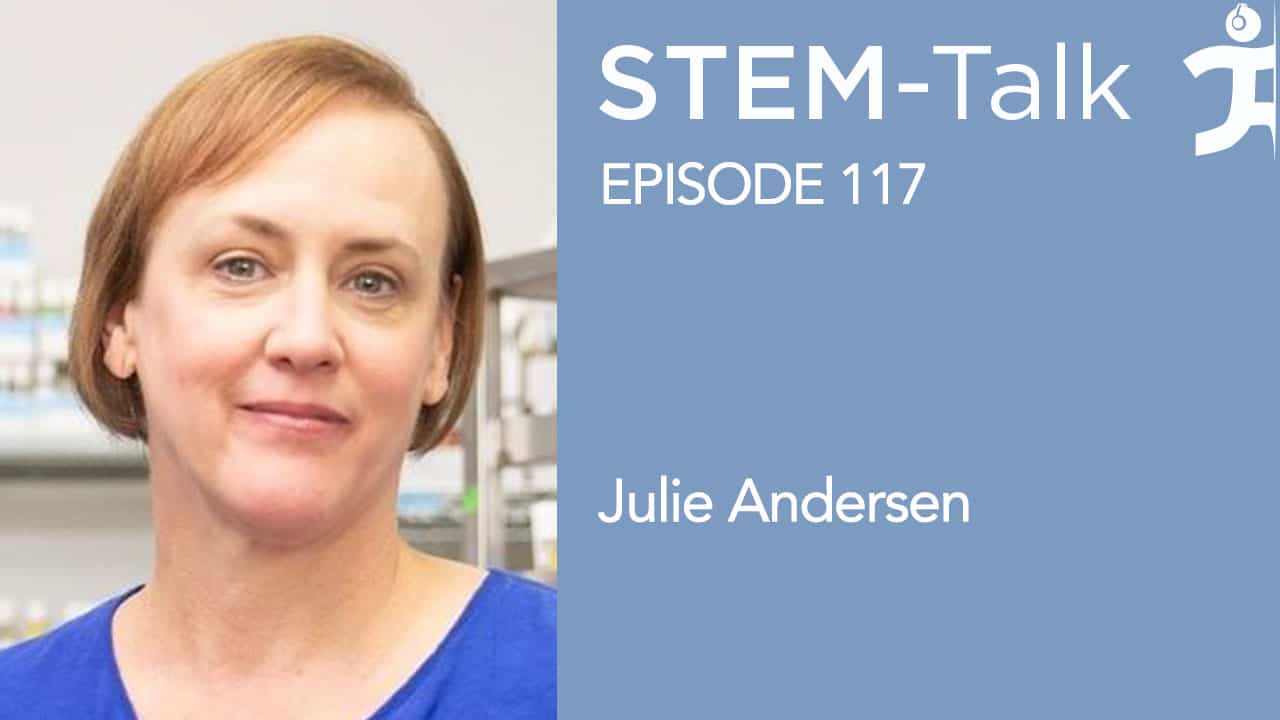STEM-Talk
Episode 117: Julie Andersen talks about her research into aging and neurodegenerative diseases
// Jan 12, 2021

Our guest today is Dr. Julie Andersen, who is best known for her research into aging and age-related diseases. A professor at the Buck Institute Buck Institute for Research on Aging, an independent biomedical research institute that researches ways to extend the healthy years of life, Julie and her colleagues at Buck have focused on understanding the underlying age-related processes driving neurodegenerative diseases in order to identify novel therapeutics.
Because our conversation with Julie was so fascinating and long, we have divided it into two parts. In today’s part one of her interview, we talk to Julie about her youth and early career. We also talk to her about the potential of of rapamycin to protect brain cells and mitochondria in a mouse model of Parkinson’s disease as well as her thoughts about the Amyloid Cascade Hypothesis. In part two, which will go live in a few weeks, we have an in-depth conversation with Julie about her research into the neuroprotective properties of urolithin A.
In terms of Julie’s background, she received her Ph.D. from UCLA and did her post-doc in the department of neurology at Harvard. In 2000 Julie joined the Buck Institute.
Show notes:
[00:03:33] Dawn opens the interview asking if it is true that Julie was a quiet kid who normally sat in the back of the classroom. [00:03:52] Dawn mentions that Julie was born in Montana but that she grew up in northern Idaho. Dawn asks what it was that brought Julie’s family to Idaho. [00:04:29] Dawn asks Julie what interests she had growing up. [00:05:05] Ken remarks on the fact that one of Julie’s favorite books is a biography of Clementine, Winston Churchill’s wife, and asks where Julie’s interest in Clementine came from. [00:05:46] Dawn mentions that for Julie’s undergraduate degree, she went to Washington State University, where her father was a professor. Dawn asks if Julie knew from the start that she was going to focus her undergraduate studies on plant physiology. [00:07:03] Ken asks Julie took her to UCLA for her Ph.D. [00:08:16] Dawn asks Julie what led to travel across the country to Boston for her post-doc. [00:09:26] Julie explains why she eventually returned to California after her Ph.D. [00:11:32] Dawn asks Julie to tell the story of how meeting someone she described as “a fellow nerd” at an aging conference eventually led her to taking a position at the Buck Institute. [00:14:34] Ken remarks that Julie must like working at the Buck, given she has remained there for the last 20 years. Julie describes what is it about the Buck Institute that makes it such a special place. [00:17:51] Dawn mentions that for the past 20 years, Julie and her lab at Buck have looked at a lot of different aspects of neurodegeneration, with a heavier concentration on autophagy in the past five years. Dawn goes on to mention that Julie has especially been investigating a natural bioactive known as urolithin A. Before diving into all of this work specifically, Dawn asks Julie, what drew her to the study of neurodegeneration to begin with. [00:19:55] Ken asks what prompted Julie’s current focus on autophagy. [00:24:11] Dawn explains that degradation of damaged mitochondria via lysosomal autophagy is a key cellular pathway in the maintenance of mitochondrial homeostasis. Disruption of this pathway contributes to the progressive cell loss that is associated with Parkinson’s disease. She goes on to mention that Julie published the results of a study in 2015that found rapamycin can protect brain cells and mitochondria in a mouse model of Parkinson’s disease. Julie explains the significance of this study and talks about the importance of rapamycin in the research of therapies for Parkinson’s disease. [00:30:44] Dawn asks Julie to explain the concept, and the significance of, transcription factor EB (TFEB), which is a protein that is encoded in humans by the TFEB gene, and is a master regulator of autophagy and lysosomal function. Julie explains how this has become a potential target for treating Parkinson’s and Alzheimer’s. [00:32:41:] Ken mentions that much of Julie’s work has focused on cellular senescence. Ken asks for Julie to describe the concept of senescence, as well as its impact on neurodegenerative diseases. [00:41:26] Ken mentions that exposure to the herbicide paraquat is associated with increased risk of idiopathic Parkinson’s disease. He goes on to mention that Julie published a study in 2017 that showed exposure to certain environmental toxins promotes accumulation of senescent cells in the aging brain. Julie talks about her finding that therapies targeting senescent cells may constitute a strategy for treatment of sporadic Parkinson’s disease. [00:46:47] Dawn ends part one of the interview by mentioning that Julie followed up her 2017 study with another study that examined whether one could screen known neurotoxicants for their ability to cause astrocytes, which are a mitotic-cell type in the brain important for maintaining neuronal health, to undergo senescence. Julie ends the interview with a discussion about the study, titled “Screening Method for Identifying Toxicants Capable of Inducing Astrocyte Senescence.”Links:






